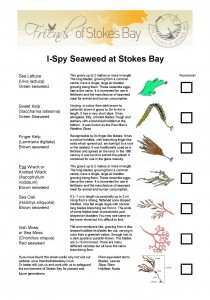Seaweed
Whilst on the shingle beach at Stokes Bay you will not see many examples of seaweed growing. There may be some pieces thrown up onto the beach, especially along the high tide and low tide marks. These have broken away from their living roots and have floated onto the shingle.
To see living growing examples you will need to explore the rock pools at low tide. Take care! seaweed coating rocks is slippery.
| Sea Lettuce (Ulva lactuca) Green seaweed. This is large, flat and almost transparent. It is common on the lower parts of the beach. It can be eaten and its blades resemble lettuce leaves, hence its name. https://www.marlin.ac.uk/species/detail/1467 |
||
| Sweet Kelp or Sugar Kelp (Saccharina latissima formerley Laminaria sacchararina) Brown seaweed. Varying in colour from dark brown to yellowish brown it grows to 2m to 4m in length. It has a very short stipe. It has elongated, frilly, crinkled blades.Tough and leathery with a branched holdfast at the bottom. The plant has a tendency to go limp when humidity is increased and becomes dry and brittle when humidity decreases – therefore it was known as the Poor Man’s Weather Glass – and was used by some to predict the weather. Today it is mainly used as either a sea vegetable ( edible seaweed ) or as an extract for the cosmetic industry for skin protection. https://www.marlin.ac.uk/species/detail/1375 |
||
| Finger Kelp or Oarweed (Laminaria digitata) Brown seaweed. Recognisable by its finger like blades. It has a conical holdfast, with branching finger-like roots which spread out, anchoring it to a rock or the seabed. It was traditionally used as a fertiliser and spread on the land. In the 18th century it was burnt to extract the potash it contained for use in the glass industry. In the 19th century it was used for the extraction of iodine. https://www.marlin.ac.uk/species/detail/1386 |
||
| Egg Wrack or Knotted Wrack (Ascophyllum nodosum) Brown seaweed. This grows up to 2 metres or more in length. The long blades, growing from a common centre, have a single, large air bladder growing along them. These resemble eggs, hence the name. It is harvested for use in fertilisers and the manufacture of seaweed meal for animal and human consumption. https://www.marlin.ac.uk/species/detail/1336 |
||
| Sea Oak (Halidrys siliquosa) Brown seaweed 0.3 -1 m in length (occasionally up to 2 m) rising from a strong, flattened cone shaped holdfast. One flat single stype with several long blades branching out from it. The ends of some blades bear characteristic pod-shaped air bladders You may see some on the lower shore but it is difficult to find. https://www.marlin.ac.uk/species/detail/1450 |
||
| Irish Moss, or Sea Moss (Chondrus crispus) Red seaweed Flat and membrane like, growing from a disc shaped holdfast its blades fan out, varying in color from a greenish-yellow, through red, to a dark purple or purplish-brown. The blades are 2–15 mm broad. There are many diifferent varieties but all have the same branchinng form. This can be edible and is often known as Caragheen Moss in Ireland. It is rich in iodine and sulphur. https://www.marlin.ac.uk/species/detail/1444 |
||
 |
The next time you are going to visit Stokes Bay Beach download, print and take this handy guide with you. See if you can find an example of each.
|